Related Research Articles

The Gaza Strip, or simply Gaza, is a polity and the smaller of the two Palestinian territories. On the eastern coast of the Mediterranean Sea, Gaza is bordered by Egypt on the southwest and Israel on the east and north.

The Gaza–Israel barrier is a border barrier located on the Israeli side of the Gaza–Israel border. Before the 2023-24 Israel-Hamas war, the Erez Crossing, in the north of the Gaza Strip, used to be the only crossing point for people and goods coming from Israel into the Gaza Strip, with a second crossing point, the Kerem Shalom border crossing, used exclusively for goods coming from Egypt, as Israel didn't allow goods to go directly from Egypt into Gaza through the Egypt–Gaza border, except for the Salah Al Din Gate, opened in 2018.
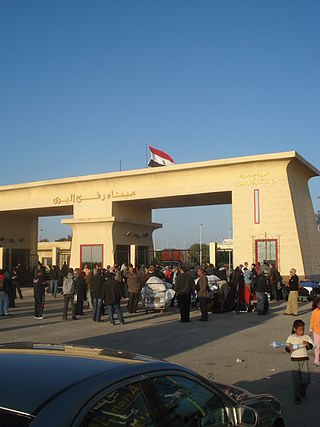
The Rafah Border Crossing or Rafah Crossing Point is the sole crossing point between Egypt and Palestine's Gaza Strip. It is located on the Egypt–Palestine border. Under a 2007 agreement between Egypt and Israel, Egypt controls the crossing but imports through the Rafah crossing require Israeli approval.

The Erez Crossing, also known as the Beit Hanoun Crossing, is a border crossing between the Gaza Strip and Israel. It is located at the northern end of the Gaza Strip, between the Israeli kibbutz of Erez and the Palestinian town of Beit Hanoun.

On 23 January 2008, Hamas militants in the Gaza Strip set off an explosion near the Rafah border crossing, destroying part of the 2003 wall. The United Nations estimates that as many as half the 1.5 million population of the Gaza Strip crossed the border into Egypt seeking food and supplies. Due to fears that militants would acquire weapons in Egypt, Israeli police went on increased alert.

A blockade has been imposed on the movement of goods and people in and out of the Gaza Strip since Hamas's takeover in 2007, led by Israel and supported by Egypt. The blockade's current stated aim is to prevent the smuggling of weapons into Gaza; previously stated motivations have included exerting economic pressure on Hamas. Human rights groups have called the blockade illegal and a form of collective punishment, as it restricts the flow of essential goods, contributes to economic hardship, and limits Gazans' freedom of movement. The blockade and its effects have led to the territory being called an "open-air prison".
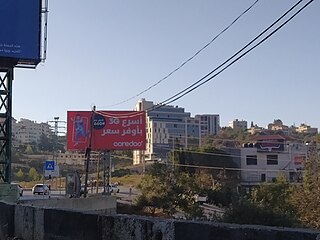
Communications in the State of Palestine occur across many media, including telephone, radio, television, and internet. The telecom infrastructure is growing at a very rapid pace and continually being updated and expanded.

Egypt–Palestine relations are the bilateral relations between the Arab Republic of Egypt and the State of Palestine. Egyptian President Gamal Abdel Nasser was a strong supporter of the Palestinian cause and he favored self-determination for the Palestinians. Although the Egyptian government has maintained a good relationship with Israel since the Camp David Accords, most Egyptians strongly resent Israel, and disapprove of the close relationship between the Israeli and Egyptian governments.

Jahafil Al-Tawhid Wal-Jihad fi Filastin is a Sunni Islamist Palestinian group in the Gaza Strip and the Sinai peninsula, and is the branch of al-Qaeda in Gaza. The establishment of the group was publicly announced on 6 November 2008, with communiqués vowing loyalty to al-Qaeda, after having "received the messages of Osama bin Laden and Ayman Al-Zawahiri." Various forms of the "Tawhid al-Jihad" label have appeared in relation to developments in the Gaza Strip. The size of the group is not publicly known.

Hamas has governed the Gaza Strip in Palestine since its takeover of the region from rival party Fatah in June 2007. Hamas' government was led by Ismail Haniyeh from 2007 until February 2017, when Haniyeh was replaced as leader of Hamas in the Gaza Strip by Yahya Sinwar. As of November 2023, Yahya Sinwar continues to be the leader of Hamas in the Gaza Strip. Due to the ongoing Israel–Hamas war, Hamas lost control of most of the northern part of the Gaza Strip.
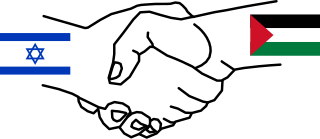
The Agreement on Movement and Access (AMA) was an agreement between Israel and the Palestinian Authority (PA) signed on 15 November 2005 aimed at improving Palestinian freedom of movement and economic activity within the Palestinian territories, and open the Rafah Crossing on the Gaza–Egypt border. AMA was described as: ″an agreement on facilitating the movement of people and goods within the Palestinian Territories and on opening an international crossing on the Gaza-Egypt border that will put the Palestinians in control of the entry and exit of people.″ Part of the agreement was the Agreed Principles for Rafah Crossing.

The 2014 Gaza War, also known as Operation Protective Edge, and Battle of the Withered Grain, was a military operation launched by Israel on 8 July 2014 in the Gaza Strip, a Palestinian territory that has been governed by Hamas since 2007. Following the kidnapping and murder of three Israeli teenagers in the West Bank by Hamas-affiliated Palestinian militants, the Israel Defense Forces (IDF) initiated Operation Brother's Keeper, in which some 350 Palestinians, including nearly all of the active Hamas militants in the West Bank, were arrested. Hamas subsequently fired a greater number of rockets into Israel from the Gaza Strip, triggering a seven-week-long conflict between the two sides. It was one of the deadliest outbreaks of open conflict between Israel and the Palestinians in decades. The combination of Palestinian rocket attacks and Israeli airstrikes resulted in over two thousand deaths, the vast majority of which were Gazan Palestinians. This includes a total of six Israeli civilians who were killed as a result of the conflict.

Rami Aman is a Palestinian journalist and peace activist in the Gaza Strip. Aman founded the Gaza Youth Committee, through which since 2015 Aman has been organizing small-scale video chats between Israelis and Palestinian peace activists in the Gaza Strip in an initiative called "Skype With Your Enemy." On 9 April 2020, Aman was arrested by Hamas at the Internal Security headquarters in Gaza City. He was charged with "weakening revolutionary spirit" for his role in organizing the April 2020 video call with Israelis. He was released in October 2020.
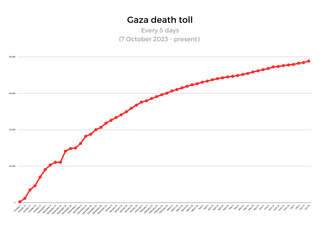
On 9 October 2023, Israel intensified the blockade of the Gaza Strip in response to the beginning of the Israel–Hamas war and the 7 October attack on Israel by Hamas-led Palestinian militants. Israel's Defense Minister Yoav Gallant announced a "total blockade", blocking the entry of food, water, medicine, fuel and electricity. Israel stated that the blockade would not be lifted until the hostages abducted by Hamas are returned, while Hamas stated that it would release all Israeli hostages in exchange for the release of all Palestinian prisoners by Israel. Later, Gallant changed his position of a complete blockade. On 18 October 2023, United States President Joe Biden announced that Israel and Egypt had agreed to allow humanitarian aid to enter the Gaza Strip, with the first supplies entering on 21 October 2023. The blockade exacerbated Gaza's humanitarian crisis.
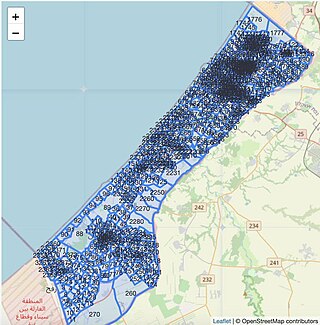
During the Israel–Hamas war, the Israeli military ordered most residents of Gaza to evacuate their homes, displacing hundreds of thousands of people and contributing to a broader humanitarian crisis in the territory. It is the largest displacement of Palestinians in 75 years. Palestinians have described the evacuation as the "second Nakba."
Manar al-Sharif is a Palestinian Syrian journalist and peace activist.
Motaz Hilal Azaiza is a Palestinian photojournalist from Gaza. He is known for covering the Israel–Hamas war, drawing a large social media following. In 2023, he was named Man of the Year by GQ Middle East and one of his photos, showing a girl trapped in rubble from an Israeli air strike, was named one of Time's top 10 photos of 2023, and was featured on Time's list of the 100 most influential people of 2024.
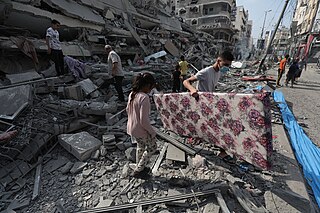
The Gaza Strip is experiencing a humanitarian crisis as a result of the Israel–Hamas war. The crisis includes both a famine and a healthcare collapse. At the start of the war, Israel implemented a complete blockade on the Gaza Strip, which has resulted in significant shortages of fuel, food, medication, water, and essential medical supplies. This siege resulted in a 90% drop in electricity availability, impacting hospital power supplies, sewage plants, and shutting down the desalination plants that provide drinking water. Widespread disease outbreaks have spread across Gaza.
The We Want to Live movement is a grassroots youth movement in the Gaza Strip calling for increased economic opportunity and the removal of Hamas from power. The movement was founded in March 2019, giving rise to the 2019 Gaza economic protests. It is not connected to any one political party, and some sources have connected the movement to the Arab Spring of the early 2010s.

Mirna El Helbawi is an Egyptian journalist, writer, podcaster and activist. She is the founder of Connecting Humanity, a non-profit organisation that helps people in Gaza to regain access to the internet, using donated eSIMs. She was nominated for the Arab Journalism Award in 2016.
References
- 1 2 Vo, Lam Thuy (2023-11-07). "'Let Me Tell Them Goodbye Before They Get Killed': How eSIM Cards Are Connecting Palestinian Families – The Markup". themarkup.org. Retrieved 2024-03-19.
- ↑ Kershner, Isabel; Nereim, Vivian; Shankar, Vivek; Rogers, Katie (29 October 2023). "Gazans had no cell service. An effort led from Egypt helped reconnect them". The New York Times.
- ↑ "This activist is helping Palestinians get back online in Gaza when connection is lost under Israeli attack". CNN. 2023-12-04. Retrieved 2024-03-19.
- 1 2 3 4 5 6 Español, Marc (2024-01-29). "The Egyptians who have sent more than 130,000 digital cell phone cards to Gaza to defy blackouts". EL PAÍS English. Retrieved 2024-03-20.
- 1 2 Aly, Rasha (2023-12-17). "Palestinians in Gaza using eSim cards to get around communications blackout". The Guardian. ISSN 0261-3077 . Retrieved 2024-03-19.
- ↑ "When Gaza lost telephone and internet connection, this activist found a way to get Palestinians back online". The Mercury News. 2023-12-03. Retrieved 2024-03-19.
- ↑ "Why Gaza keeps losing communications". Washington Post. 2024-01-16. Retrieved 2024-03-19.
- ↑ Vo, Lam Thuy (2023-11-07). "'Let Me Tell Them Goodbye Before They Get Killed': How eSIM Cards Are Connecting Palestinian Families – The Markup". themarkup.org. Retrieved 2024-03-19.
- ↑ "What is an eSIM? Here's all you need to know in 2024". Saily. Retrieved 2024-04-26.
- ↑ Collier, Kevin; Abdelkader, Rima (19 January 2024). "Palestinians are using donated eSIM cards to stay in touch with the outside world". NBC News. Retrieved 26 April 2024.
- ↑ "How eSims are helping thousands in Gaza stay connected amid blackouts". NPR.
- ↑ Hesham, Merna (2024-03-19). "'Palestinians won't be silenced again!' : Egyptian journalist Mirna El-Helbawi initiative to get Gaza back online". Ahram Online.
- ↑ "eSims For Gaza". gazaesims.com. Retrieved 2024-03-19.
- ↑ Elassar, Alaa; Tucker, Emma (2023-12-03). "When Gaza lost phone and internet under Israeli attack, this activist found a way to get Palestinians back online". CNN. Retrieved 2024-03-19.